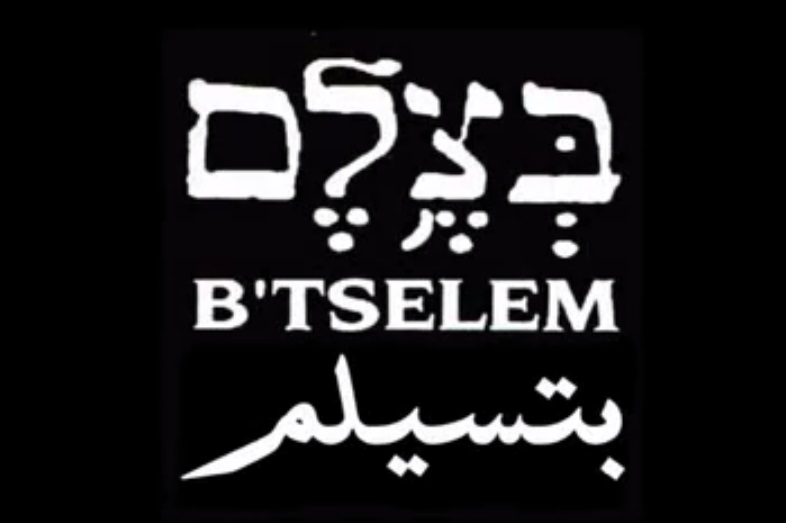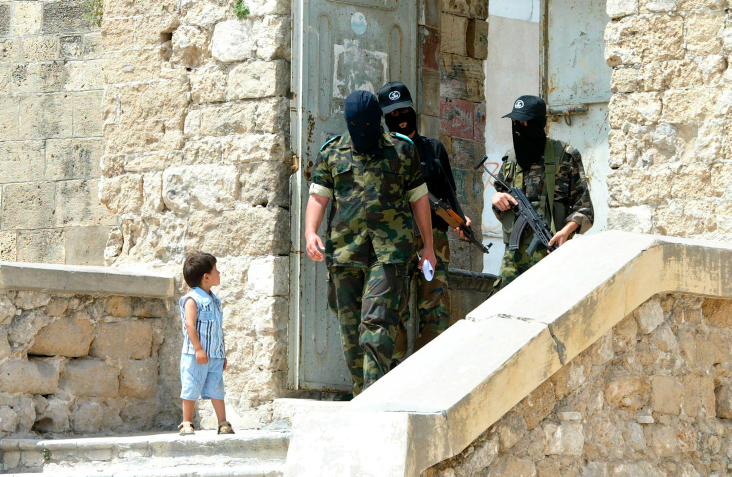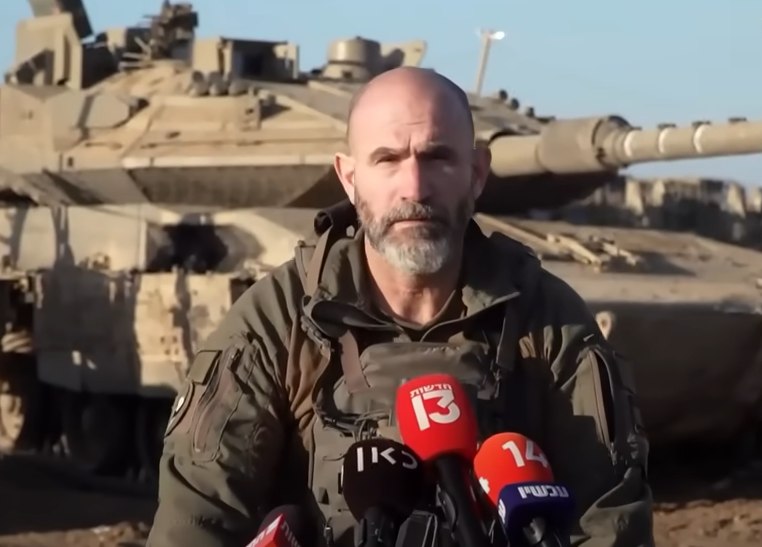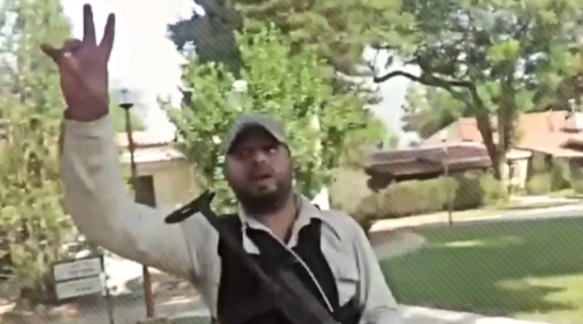B’Tselem, a group formally dedicated to human rights in general, refuses to call Hamas a terrorist organization. No-one should be surprised.
The fact that the head of B’Tselem refuses to call Hamas a ‘terrorist organization’ is no surprise • All throughout Protective Edge, B’Tselem served as the de facto propaganda arm of Hamas, doing everything in its power to undermine the legitimacy of the IDF’s operations • Among other things, B’Tselem consistently emphasized Palestinian losses while making no mention of Hamas’ cynical use of the civilian population as human shields • Even Ismail Haniyeh seems pleased

Those following B’Tselem’s activity throughout Protective Edge would not be surprised to learn that head of B’Tselem Hagai Elad refused to call Hamas a terrorist organization. Indeed, search for the word “terror” on B’Tselem’s website and the first two hits will refer to the Israeli extreme right and the methods of the State of Israel itself. B’Tselem consistently referred to these murderous groups as “armed Palestinian groups” and nothing more. While the IDF was fighting, bleeding and dying to protect the citizens of the country, B’Tselem served on the front lines of the anti-Israel propaganda machine with a mixture of demagoguery, questionable sources and the pretense of objectivity.
Whoever has more dead is more right?
How do they do this? A survey of material published by B’Tselem, one of the largest beneficiaries of the NIF ($255,477.23 in 2012), from July 8th provides the answer. B’Tselem published 8 updates on casualties during Protective Edge. Under the deniability cover of an “initial investigation,” every report compared the number of dead on the Israeli side and the number of Palestinian side. This information was published on B’Tselem’s website, in their press releases and on social media. Naturally, B’Tselem emphasized the number of children, minors, women and elderly among those killed in Gaza, backed by visual aids.
If B’Tselem took care to note the number of combatants killed (by its own definitions) in its first 6 releases, this category disappeared in the last two releases, turning all Palestinian casualties into civilians until proven otherwise. B’Tselem explained the sudden change thus: “the data is very initial and partial, and still being checked […] over the next few months B’Tselem will continue to look into the events and in this framework confirm the identity of those killed and figure out who participated in the fighting.” Why did B’Tselem repeatedly publish partial, unconfirmed data? Didn’t they care that this would serve solely to bash Israel? Probably not. Meanwhile, while B’Tselem was coy about identifying members of Palestinian terrorist groups among the dead, they were consistent and clear about dividing between Israeli ‘soldiers’ and ‘civilians’.
In addition, these reports were padded with lachrymose visual aids, of the kind meant to bypass the reader’s critical faculties, among them “tear-jerking” testimonies of Gazans, who talk of being unable to sleep at night for fear of IDF bombardment, how their life isn’t a life and an impassioned appeal to the world not to “stand aside.” We should note that B’Tselem did indeed publish testimonies of residents of the south of Israel who live under constant rocket fire. But as B’Tselem itself admitted, symmetry is more important than nationality for them: “We report more on Palestinians who are harmed because many, many more Palestinians were harmed during the operation. This in spite of the fact that most of the casualties did not take any part in the fighting [note: such a categorical statement based on what they themselves call “initial and partial data”! – A.W.] […] reporting needs to reflect reality and reality is not symmetrical when it comes to the extent of damage in Gaza and Israel and therefore it is presented before you in this manner.” B’Tselem even tried to launch a campaign of reading the names of dead Palestinian children on the radio, which was banned by the Broadcasting Authority and rejected by the Israeli Supreme Court. B’Tselem also released photo albums and video clips of the destruction in the Gaza Strip. After all, property destruction is ipso facto against international law. Who cares if the building served as a command or combat post? B’Tselem certainly couldn’t be bothered to find out if they were.

When the cat guards the cream
At best, the “initial” data which B’Tselem published were confirmed by other human rights organization in the Strip. At worst, they were solely based on Palestinians in the field. We’ve already exposed the problem of sole reliance on Palestinian testimony in the past. The assumption that a Palestinian, who sees the IDF and the State of Israel as an enemy at best and evil incarnate at worst, will do his best to provide an objective report is simply absurd.
In the case of Gaza, things are even worse. First, the Gazan population is on the whole more hostile than in the West Bank. Second, Hamas has not hesitated in the past to arrest, wound or kill people who oppose them. Given what we know about Hamas threats to foreign journalists who step out of line, it’s not hard to imagine our prospective Palestinian source fudging the truth to protect himself and his family – even if he truly wanted to give an accurate account of events. As an organization which attests that “reports issued by B’Tselem have gained a name for credibility,” and that “B’Tselem takes care to ensure the reliability of the information it releases in its name, only releasing the information after in-depth field investigations and cross-checking data and testimonies,” it would seem that during Protective Edge, B’Tselem didn’t even come close to living up to its own standards.
It’s worth mentioning here that all B’Tselem material is translated into English for its website on for dissemination on its website and on social media. The amount of energy and resources they invest to translate its publication fits nicely with its stated goal: “to fight human rights violations in the territories, by documenting them and bringing them before the broader public and policy makers [in Israel – E.G.]; to fight the phenomenon of repression and denial present in Israeli society; and to contribute to the creation of a culture of human rights in Israel,” this by providing “a maximum of information to the knowledge of the citizens of Israel.” (My emphases – E.G.) Well, everyone knows that all Israelis speak English as their mother tongue, after all. Either that, or B’Tselem has another audience in mind.
In practice, many of those who use B’Tselem’s material are anti-semitic Hamas supporters. A good example is satellite channel “Press TV”, the Iranian Ayatollahs’ propaganda mouthpiece since 2007. The channel attacks Israel at every available opportunity and has often been accused of anti-Semitism, hosting Holocaust deniers, and granting one-sided favorable coverage to terrorist organizations. Among other reasons, the channel was established to fight the Qatari-Sunni propaganda behemoth known as al-Jazeera, which also never misses an opportunity to bash Israel. Because of their common support for Hamas, each side for its own reasons, and in spite of the rivalry between these two networks, both outdid themselves this month in providing extremely slanted coverage of Protective Edge. There’s something else which stood out: both used B’Tselem’s publications to bash Israel. After all, what could be more convenient than an organization dedicated to human rights – run by Israeli Jews, yet! – to prove that Israel is committing war crimes and show how evil it is?

Selective proportionality
The second spearhead was launched by B’Tselem head Hagai Elad, formerly head of the Israeli Civil Liberties Union, also a major recipient of NIF largesse ($900,795.41 in 2012 in total).
Already at the beginning of the Operation, on July 9th, B’Tselem called attacks on the houses of terrorists as ‘a violation of international humanitarian law’. Because of this, per B’Tselem, these targets cannot serve as an excuse for collateral damage to civilians (property and lives). This event shows how B’Tselem applies blame for those killed in bombings. Thus, when the home of the Karawe family was attacked, as reported by B’Tselem, it was specifically stated that on July 8th, the family received a phone warning at 1:30 PM. “One of the sons, Ouda Karawe, is an activist in Hamas’ military wing. The family initially obeyed the order and left the house, but then they and dozens of others congregated around it.” At 2:50 PM, a UAV dropped a small bomb on one of the solar boilers, in what is known as the “knock on the roof” procedure. In spite of this, “a few minutes after the firing, the family members and neighbors went up to the roof of the house. At 3:00 PM, a missile was fired at the house from an F-16. At this stage there were four people on the roof and additional people in the stairwell or in the courtyard, on their way to the roof. The roof collapsed from the missile’s explosion and eight people, six of them children, were killed. Additionally 28 people were wounded, ten of them seriously.” Ouda Karawe, the original target, was not among the dead.
Although they were warned both by telephone and through a warning bombing, B’Tselem blames the IDF for the innocent casualties, since for them the bombing itself was not justified by international law. Assuming B’Tselem’s own report is perfectly accurate, we have before us a clear cut case of civilians being used as human shields. In spite of this, B’Tselem doesn’t seem to wonder why the civilians insisted on staying on or near the roof after both the warning and the knock on the roof, and somehow it does not assign a smidgen of blame to Hamas or even the family members, who enabled others to follow them in trying to protect the house with their bodies.
In the wake of the bombing, B’Tselem and nine other human rights organizations – all NIF-supported – appealed to Attorney General Yehuda Weinstein “to instruct the government to avoid attacks which may cause disproportionate damage to civilians in the Gaza Strip and act to establish an external, independent and effective mechanism for examining decisions and instructions at the political and command levels regarding the conduct of the fighting.” Weinstein was not impressed, and he summarily rejected their demands. According to him, all of the IDF’s strikes stand the test of proportionality and international law, and he even reminded them that because of “the cynical and criminal exploitation” by Hamas of “the civilian population as a human shield protecting from IDF strikes”, “unfortunately even legal and proportional attacks can cause unintended and undesired harm to civilians and civilian property.”

But when you fire the arrow and paint the target around it, even such an authoritative legal opinion is not enough. Indeed, Hagai Elad stuck to this line in his two appearances in the foreign media. The first took place the first day after B’Tselem’s publication on the matter. At the beginning of his Sky News interview, Elad was asked what he thinks of the IDF’s claim that they’re doing everything they can to minimize harm to civilians. Elad responded that attacks on the houses of Hamas members “are in and of themselves a violation of humanitarian law” [ducking the actual issue – A.W.]. The host wouldn’t give up and questioned Elad regarding the argument that Hamas uses the civilian population as human shields, making it very hard not to hit civilians when attacking terrorist organizations in the Strip. Elad didn’t answer. Instead, he continued to read from a prepared list of points, including the change of the IDF’s version of events in bombing terrorists’ houses as mentioned above.
What about Hamas’ rocket fire? Well, in Elad’s eyes this is also “illegal”, but the difference is that Israel, “thanks to ‘Iron Dome’ and shelters and so on, there haven’t been dead so far. In Gaza […] there are no shelters and the result we see is the unacceptable level of killed.” Ostensibly, per Elad and others like him, Israel should have taken no offensive action at all. It needs to suck it up and be hit with rockets, or at the very least only kill as many as they lost. In an interview to al-Jazeera, he clarified that rocket stockpiles and launchers are indeed a military target. But once again, he emphasized that attacking terrorists’ houses is illegal and it is what led to the “horrific” pictures of civilian casualties in Gaza [again, being very categorical with “initial” information – A.W.]. “We have a lot of experience in documenting military operations in Gaza […] and we will follow them, but […] it’s important for us to say already now, while the attacks are happening, to declare their illegality.”
Tying the IDF’s hands
As we saw above, B’Tselem’s insistence on proportionality and international law is almost exclusively in one direction, and for them the criminal liability falls solely on the Israeli side. In light of this, is in any way surprising that eight months ago Hamas leader Ismail Haniyeh praised “all the committees, people, civil society organizations and human rights organizations, who acted to break the siege of Gaza and the struggle against the fence and the settlements”? Haniyeh stated that “in order to build a Palestinian national strategy,” one must close ranks and include “all possible methods and means including: the armed struggle, the popular struggle, the political and diplomatic struggle, the public relations struggle, the public and legal and academic boycott and diplomatic struggle, and it needs to take place in all regional and international arenas.” In this campaign, it would seem that B’Tselem and its NIF-funded partners are doing their part well.
As of this writing we have not received a response from either the NIF or B’Tselem. They will be published once they are received.
English translation by Avi Woolf.
To receive updates on new articles in English, join Mida on Facebook or Twitter or join our mailing list.



